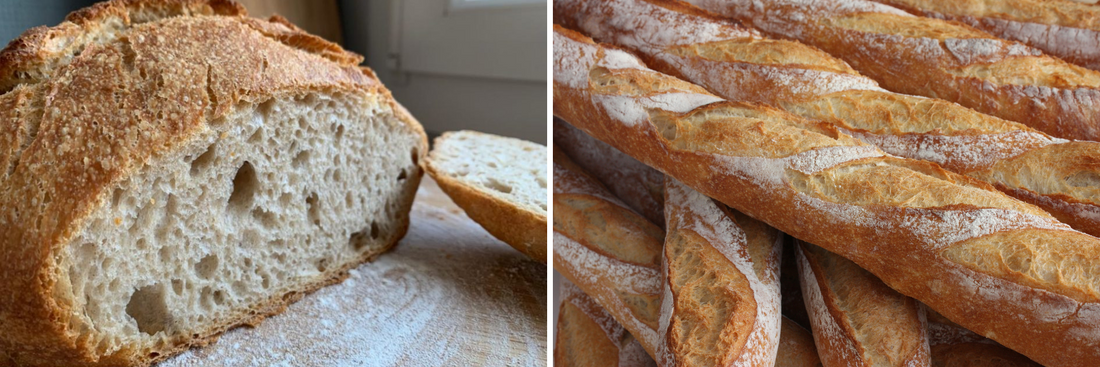Both French bread and Italian bread are pillars of European baking, each with rich traditions, distinctive flavors, and signature styles. While they may appear similar at a glance, there are clear differences in shape, ingredients, texture, and culinary use. Whether you're a baker, chef, or bread lover, understanding the difference between French bread vs Italian bread can elevate how you enjoy or serve each loaf.
French Bread vs Italian Bread: Shape & Appearance Comparison
French Bread is typically recognized by its elongated, uniform shapes. The most iconic form is the baguette — a long, thin loaf with a crisp golden crust and tapered ends. Other traditional forms include the boule (a round, rustic loaf) and the ficelle, which is similar to a baguette but thinner and often more delicate. French loaves tend to have a cleaner, symmetrical shape with scored tops to guide crust formation.
Exploring the Types of French Bread: From Baguette to Brioche
Baguette vs French Bread: How to Choose the Right Loaf for Any Meal
In contrast, Italian Bread varies more widely in shape and appearance, depending on the region. Common styles include ciabatta, which has a wide, flat, and rustic shape with an open crumb and flour-dusted surface. Focaccia is a flatbread baked in a pan, often topped with herbs, olives, or tomatoes, and cut into squares or strips. Italian loaves like pane casereccio or filone tend to be shorter, rounder, and denser, with a darker, more rustic crust.

French Bread vs Italian Bread: Ingredient & Flavor Profile
The key distinction in ingredients lies in enrichment.
French Bread, especially traditional baguettes, is made using only four ingredients: flour, water, salt, and yeast. French baking laws (such as the 1993 "Décret Pain") restrict the use of additives in traditional breads. The absence of fat, sugar, or dairy results in a clean, slightly sweet flavor driven by the natural fermentation and wheat quality.
Italian Bread, however, often includes olive oil, milk, sugar, or herbs depending on the variety. For example, focaccia is enriched with olive oil both in the dough and brushed on top before baking, which enhances its savory depth. Ciabatta typically contains a higher hydration dough, sometimes with olive oil, contributing to its chewy texture and nutty, fermented flavor. As a result, Italian breads tend to be more flavorful, savory, and aromatic, especially when paired with herbs or toppings.

French Bread vs Italian Bread: Baking Methods & Regional Variations
French Bread is traditionally baked in deck ovens that utilize steam injection. This steam helps develop the iconic crusty exterior while preserving moisture inside. French bakers often follow strict protocols to achieve uniform crust, color, and scoring; especially for baguettes and boules. Artisan bakeries may also use slow fermentation and cold proofing to enhance flavor and texture.
Italian Bread encompasses more regional diversity and varied baking techniques. Wood-fired or stone ovens are common, particularly in traditional panifici. Focaccia is typically baked in sheet pans, giving it a soft, oily bottom and a golden top. Many Italian breads use high-hydration doughs, especially ciabatta, to create an open, airy crumb. Baking conditions, humidity, and oven types vary by region.
Regional Variants:
-
In France, regional varieties include fougasse, a decorative, flatbread-style loaf similar in texture to focaccia but shaped with leaf-like slits.
-
In Italy, each region boasts its own styles: pane Toscano is unsalted and used with salty meats or cheese; pane di Altamura is made from durum wheat; Sicilian breads often feature sesame seeds and semolina-rich doughs.
French Bread vs Italian Bread: Typical Uses & Culinary Pairings
French Bread is versatile and often served at breakfast or with light meals:
-
Baguettes are used for sandwiches (e.g., jambon-beurre), sliced for crostini, or torn and served with jam, butter, or soft cheeses.
-
The mild flavor makes it ideal for sweet spreads, breakfast toast, or a neutral base for strong flavors like pâté or blue cheese.
Italian Bread is commonly paired with savory dishes and olive oil-based accompaniments:
-
Ciabatta and filone are ideal for rustic sandwiches, such as panini or meatball subs.
-
Focaccia is served as an antipasto, sliced with olive oil and balsamic vinegar, or topped with tomato, onion, and herbs.
-
Denser loaves are excellent for sopping up soups and sauces, while sliced versions are used in bruschetta, panzanella salad, or baked dishes like lasagna.
FAQs About French Bread vs Italian Bread
What is the difference between French bread and Italian bread?
French bread is typically longer, thinner, and crustier. Italian bread is often shorter, denser, and may include olive oil or other enrichments.
Are French and Italian breads made with different ingredients?
Yes. French bread usually contains only flour, water, yeast, and salt. Italian bread often includes olive oil, milk, or sugar.
Which bread has crisper crust: French bread or Italian bread?
French bread has the crispier crust, especially baguettes, due to steam baking.
Is ciabatta an Italian version of French baguette?
No. Ciabatta is flatter, more rustic, and uses high-hydration dough. It’s different in texture and shape from a baguette.
Why is Italian bread chewier and denser than French bread?
Italian bread often has added fat and higher hydration, resulting in a chewier, denser crumb.
Can French bread include olive oil or sugar?
Traditional French bread does not include oil or sugar. These are not allowed in classic baguettes by French baking law.
What Italian breads pair best with sauces or olive oil?
Ciabatta, focaccia, and pane casereccio are ideal for dipping and pairing with olive oil or tomato-based sauces.
Conclusion
Choosing between French bread and Italian bread depends on your flavor preferences and how you plan to use it. French bread is ideal for a crisp crust and subtle flavor, perfect for sandwiches or toast. Italian bread, with its denser texture and savory notes, is excellent for dipping, pairing with olive oil, or hearty meals. Both offer unique qualities — and knowing the difference helps you make the best choice for any occasion.







